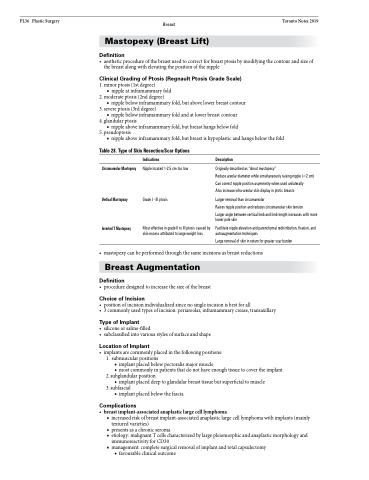Page 1158 - TNFlipTest
P. 1158
PL36 Plastic Surgery
Breast Toronto Notes 2019 Mastopexy (Breast Lift)
Definition
• aestheticprocedureofthebreastusedtocorrectforbreastptosisbymodifyingthecontourandsizeof the breast along with elevating the position of the nipple
Clinical Grading of Ptosis (Regnault Ptosis Grade Scale)
1. minor ptosis (1st degree)
■ nipple at inframammary fold
2. moderate ptosis (2nd degree)
■ nipple below inframammary fold, but above lower breast contour
3. severe ptosis (3rd degree)
■ nipple below inframammary fold and at lower breast contour
4. glandular ptosis
■ nipple above inframammary fold, but breast hangs below fold
5. pseudoptosis
■ nipple above inframammary fold, but breast is hypoplastic and hangs below the fold
Table 28. Type of Skin Resection/Scar Options
Circumareolar Mastopexy
Vertical Mastopexy
Inverted T Mastopexy
Indications
Nipple located 1-2.5 cm too low
Grade I - III ptosis
Most effective in grade II to III ptosis caused by skin excess attributed to large weight loss
Description
Originally described as “donut mastopexy”
Reduce areolar diameter while simultaneously raising nipple (<2 cm)
Can correct nipple position asymmetry when used unilaterally
Also increase infra-areolar skin display in ptotic breasts
Larger removal than circumareolar
Raises nipple position and reduces circumareolar skin tension
Larger angle between vertical limb and limb length increases with more lower pole skin
Facilitate nipple elevation and parenchymal redistribution, fixation, and autoaugmentation techniques
Large removal of skin in return for greater scar burden
• mastopexycanbeperformedthroughthesameincisionsasbreastreductions
Breast Augmentation
Definition
• proceduredesignedtoincreasethesizeofthebreast
Choice of Incision
• positionofincisionindividualizedsincenosingleincisionisbestforall
• 3commonlyusedtypesofincision:periareolar,inframammarycrease,transaxillary
Type of Implant
• siliconeorsaline-filled
• subclassifiedintovariousstylesofsurfaceandshape
Location of Implant
• implantsarecommonlyplacedinthefollowingpositions: 1. submuscular positions
◆ implant placed below pectoralis major muscle
◆ most commonly in patients that do not have enough tissue to cover the implant 2. subglandular position
◆ implant placed deep to glandular breast tissue but superficial to muscle 3. subfascial
◆ implant placed below the fascia
Complications
• breastimplant-associatedanaplasticlargecelllymphoma
■ increased risk of breast implant-associated anaplastic large cell lymphoma with implants (mainly textured varieties)
■ presents as a chronic seroma
■ etiology: malignant T cells characterized by large pleiomorphic and anaplastic morphology and
immunoreactivity for CD30
■ management: complete surgical removal of implant and total capsulectomy
◆ favourable clinical outcome


